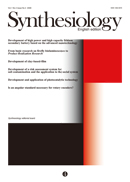Volume 1, Issue 4
Displaying 1-11 of 11 articles from this issue
- |<
- <
- 1
- >
- >|
Research papers
-
2009Volume 1Issue 4 Pages 221-232
Published: 2009
Released on J-STAGE: October 06, 2009
Download PDF (6520K) -
2009Volume 1Issue 4 Pages 233-241
Published: 2009
Released on J-STAGE: October 06, 2009
Download PDF (1262K) -
2009Volume 1Issue 4 Pages 242-250
Published: 2009
Released on J-STAGE: October 06, 2009
Download PDF (996K) -
2009Volume 1Issue 4 Pages 251-262
Published: 2009
Released on J-STAGE: October 06, 2009
Download PDF (1449K) -
2009Volume 1Issue 4 Pages 263-272
Published: 2009
Released on J-STAGE: October 06, 2009
Download PDF (2053K) -
2009Volume 1Issue 4 Pages 273-281
Published: 2009
Released on J-STAGE: October 06, 2009
Download PDF (1348K)
Article
-
2009Volume 1Issue 4 Pages 282-290
Published: 2009
Released on J-STAGE: October 06, 2009
Download PDF (916K)
Editorial board
-
2009Volume 1Issue 4 Pages 291-292
Published: 2009
Released on J-STAGE: October 06, 2009
Download PDF (276K) -
2009Volume 1Issue 4 Pages 293-294
Published: 2009
Released on J-STAGE: October 06, 2009
Download PDF (306K) -
2009Volume 1Issue 4 Pages 295
Published: 2009
Released on J-STAGE: October 06, 2009
Download PDF (246K) -
2009Volume 1Issue 4 Pages 296
Published: 2009
Released on J-STAGE: October 06, 2009
Download PDF (262K)
- |<
- <
- 1
- >
- >|
